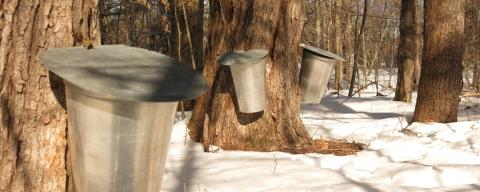March Is Maple Month: Tips for Managing Your Trees for Maple Sugar Production
New Hampshire celebrates New Hampshire Maple Month every March. This year New Hampshire Maple Weekend is March 18-19, 2023. From the trees of your local sugarbush to your table, this is a great weekend to enjoy being outdoors while supporting your local sugarhouses. You can find a listing of local sugarhouses on the New Hampshire Maple Producers Association website.
Since March is Maple Month, let’s talk about managing your trees for maple sugar production. Sap production in a sugarbush, or sugar orchard, relies on developing and maintaining large, spreading crowns in your maple trees. Sugarbushes can become overcrowded and tree vigor and sap production can decline. To achieve these larger, spreading crowns, the forest must be managed to release the crowns through thinnings and improvement cuts, ideally throughout all stages of the forest stand development. Overcrowding and competition for light and other resources negatively affect sugar content and sap volume and can reduce stand vigor.
There are management considerations for your sugarbush as you get started, and throughout the life of your orchard. Remember that tree vigor and production will decline in older maples. Establishing a new crop of trees through regeneration harvests and release of advance regeneration will sustain sap production. When conducting harvests in and around your sugarbush, pay particular attention to avoid root and stem damage. This is typically accomplished by operating during either very dry or frozen ground conditions. One thing to remember is that tapping injures the tree. When done correctly, healthy, vigorous trees will respond to tapping by compartmentalizing the wound and closing the tap hole within one to three years. Trees in poor health and those under stress during the growing season won’t respond as quickly as healthier individuals. This slower response may result in greater decay of the area and potentially a decline in overall health, production, and quality.
Other recommended management practices are all based on health and vigor of the forest stand as a whole. Manage for a diversity of species in your stand but select for healthy maples. A diverse forest is typically healthier and more resilient. Although timber quality may not be the priority in your management, a maple with good form will tolerate the stresses of wind, snow, and ice better than one with decay, cavities, and poor branching patterns. Improvement cuttings and thinnings should be done gradually. This will promote large full crowns while not opening your desired trees too much all at once. Appropriate silvicultural guidelines and Best Management Practices (BMPs) should always be followed.
For more information on maple sugaring, managing your sugarbush, and some of the history of maple sugaring, follow these links:
- https://extension.unh.edu/goodforestry/assets/docs/8-3SECURE.pdf
- https://extension.unh.edu/blog/2021/02/magic-sugar-maple
Happy sugaring!

